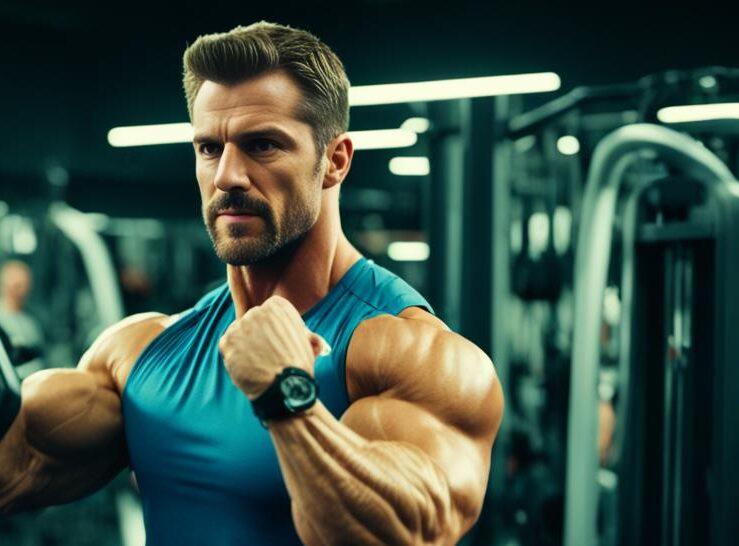Are you looking to build bigger, stronger biceps? If so, you’re in the right place. Having well-defined arms is a goal for many fitness enthusiasts, and targeted bicep workout routines can help you achieve those impressive gains.
In this article, we will explore proven bicep workout routines that will help you sculpt powerful arms and maximize muscle growth. Whether you’re a beginner or have experience in the gym, these workouts will provide you with the guidance you need to develop your biceps to their full potential.
So, if you’re ready to take your arm day routines to the next level, let’s dive in and discover the secrets to building bigger, stronger biceps.
Key Takeaways:
- Follow targeted bicep workout routines to maximize muscle growth
- Whether you’re a beginner or experienced, these workouts will help you develop impressive biceps
- Emphasize proper form and technique to ensure optimal results
- Remember to fuel your body with proper nutrition for muscle growth and recovery
- Consult with a fitness professional or trainer for guidance with your bicep workouts
The Importance of Bicep Exercises
Bicep exercises are essential for building and strengthening the muscles in your arms. They play a significant role in showcasing your strength and fitness level. To achieve maximum growth, it is important to understand different workout variables such as workout splits, sets, reps, rest periods, and workout frequency. By incorporating progressive overload techniques, you can continually challenge your muscles and stimulate growth.
The Role of Workout Variables
When it comes to bicep workouts, understanding various workout variables is crucial. Let’s take a closer look at each of them:
- Workout splits: By dividing your training sessions into specific muscle groups or movement patterns, you can optimize your workout routine and ensure adequate recovery for each muscle group, including your biceps.
- Sets: Sets refer to the number of times you perform a specific exercise. It is important to choose an appropriate number of sets based on your fitness level and goals. This will help create the necessary stimulus for muscle growth.
- Reps: Reps, or repetitions, indicate the number of times you perform an exercise within a set. Different rep ranges elicit different adaptations, such as strength, endurance, or hypertrophy. It is beneficial to incorporate a variety of rep ranges in your bicep workouts to stimulate muscle growth from different angles.
- Rest periods: Rest periods between sets and exercises are vital for muscle recovery. By giving your biceps adequate rest, you allow them to replenish energy stores and reduce the risk of injury. The length of rest periods can vary depending on the intensity of your workout and your individual recovery capabilities.
- Workout frequency: Bicep workouts should be included in your overall training program with an appropriate frequency. This frequency depends on factors such as your fitness level, recovery ability, and overall training volume. Balancing frequency ensures that your biceps receive enough stimulation without overtraining.
In addition to these workout variables, incorporating progressive overload techniques is crucial for continuous muscle growth. Progressive overload involves gradually increasing the demands placed on your muscles over time. This can be achieved by increasing the weight, reps, or sets in your bicep exercises, ensuring that your muscles are consistently challenged and adapting to new stimuli.
“Progressive overload is the key to achieving continuous muscle growth and strength gains.”
Bicep Exercise Table
| Exercise | Description | Primary Muscles Targeted |
|---|---|---|
| Barbell Curl | Holding a barbell with an underhand grip, curl the weight towards your chest while keeping your elbows stationary. | Biceps brachii, brachialis, brachioradialis |
| Dumbbell Hammer Curl | Hold a dumbbell in each hand with palms facing in, curl the weights towards your shoulders while keeping your elbows stationary. | Biceps brachii, brachialis |
| Incline Dumbbell Curl | Lie back on an incline bench, hold dumbbells with palms facing up, curl the weights towards your shoulders while keeping your upper arms stationary. | Biceps brachii (long head) |
| Preacher Curl | Sit on a preacher curl bench, position your upper arms on the pad, curl the barbell or dumbbells towards your shoulders. | Biceps brachii, brachialis (isolated) |
| Cable Curl | Attach a handle to a cable machine, hold the handle with an underhand grip, curl the handle towards your chest. | Biceps brachii, brachialis |
Integrating bicep exercises into your workout routine and understanding the importance of workout variables will help you develop and strengthen your biceps effectively. Remember to tailor your routine to your fitness level and goals, and always focus on proper form to maximize results and minimize the risk of injury.
Bicep Workout for Mass
A bicep workout focused on mass involves exercises that target all components of the biceps muscle group. The workout typically includes exercises such as standing barbell curls, incline curls, and hammer curls. By incorporating supersets and drop sets, you can increase the intensity of the workout and promote muscle growth. This workout is ideal for individuals looking to build size and strength in their biceps.
Supersets and Drop Sets
Supersets involve performing two exercises back-to-back without resting in between. This technique helps to maximize muscle stimulation and promote muscular hypertrophy. For example, you can do a superset of standing barbell curls followed by incline curls. Performing these exercises consecutively without rest challenges the muscles, leading to greater muscle recruitment and growth.
Drop sets are another effective technique to add intensity to your bicep workout. With drop sets, you start with a heavier weight and perform a set to near failure. Then, you immediately reduce the weight and continue the set without resting. This method fatigues the muscles and triggers further muscle fiber recruitment, leading to increased muscle growth.
| Exercise | Reps | Sets | Rest Between Sets |
|---|---|---|---|
| Standing Barbell Curls | 8-12 | 4 | 60-90 seconds |
| Incline Curls | 8-12 | 4 | 60-90 seconds |
| Hammer Curls | 8-12 | 4 | 60-90 seconds |
Remember to warm up before starting your workout and always maintain proper form to prevent injuries. Adjust the weight and repetitions based on your fitness level and gradually increase the intensity as you progress. It’s also crucial to listen to your body and take rest days to allow for recovery.
Bicep Workout Routines to Get Ripped
If your goal is to achieve a lean and ripped look in your biceps, a specific bicep routine can help you achieve that. This workout focuses on exercises that promote muscle definition and enhance the overall aesthetic appeal of your arms. By incorporating targeted exercises and manipulating workout variables, you can maximize the results and develop well-defined biceps.
Workout Overview
The bicep routine to get ripped includes the following exercises:
- EZ-bar curls
- Concentration curls
- Hammer curls
These exercises target different areas of the biceps, allowing for comprehensive muscle development and definition. The workout variables such as workout splits, sets, reps, rest periods, and workout frequency are strategically planned to optimize muscle growth and create a shredded appearance.
Supersets and Higher Rep Ranges
To increase the intensity of the workout and promote muscle definition, incorporate supersets and higher rep ranges into your bicep routine. Supersets involve performing two exercises back to back without resting in between. This technique keeps your muscles engaged and enhances the metabolic stress on your biceps, facilitating muscle definition.
Higher rep ranges, typically ranging from 12 to 15 reps per set, stimulate muscle endurance and improve muscle definition. This higher volume of repetitions helps create the desired ripped look in your biceps.
By utilizing supersets and higher rep ranges, you can challenge your muscles and push them to their limits, resulting in improved muscle definition and a more defined appearance.
Progressive Overload for Continued Growth
Progressive overload is a crucial principle for muscle growth and development. It involves gradually increasing the demands placed on your muscles to continually stimulate growth. To incorporate progressive overload into your bicep routine, gradually increase the weight, sets, or reps over time.
For example, start with a weight that challenges you for the designated rep range. As you become stronger, progressively increase the weight while maintaining proper form and technique. This gradual increase in resistance ensures that your biceps continue to adapt and grow.
Sample Bicep Routine to Get Ripped
| Exercise | Sets | Reps | Rest Periods |
|---|---|---|---|
| EZ-bar curls | 4 | 12-15 | 60 seconds |
| Concentration curls | 4 | 12-15 | 60 seconds |
| Hammer curls | 4 | 12-15 | 60 seconds |
Perform this bicep routine two to three times per week, allowing for at least one day of rest between sessions to facilitate recovery and promote muscle growth.
By following this bicep routine to get ripped, incorporating supersets, higher rep ranges, and progressive overload, you can achieve the chiseled, defined biceps you desire. Remember to prioritize proper form, technique, and nutrition to support your muscle growth journey.
Beginner’s Bicep Workout
Are you a beginner starting your bicep training journey? It’s important to begin with exercises that are suitable for your level of experience. This beginner’s workout is designed to help you develop a foundation in bicep training while gradually building strength and endurance.
Remember, fitness is a journey, and everyone starts somewhere. Don’t be discouraged if you can’t lift heavy weights right away or perform complex exercises. Focus on mastering the basics and gradually progressing over time.
Here is a sample beginner’s workout routine that targets your biceps:
| Exercise | Sets | Reps | Rest Periods |
|---|---|---|---|
| Dumbbell Curls | 3 | 10-12 | 60 seconds |
| Preacher Curls | 3 | 10-12 | 60 seconds |
Exercise Descriptions:
- Dumbbell Curls: Hold a dumbbell in each hand, palms facing forward, and curl the weights towards your shoulders while keeping your elbows close to your sides. Slowly lower the dumbbells back down to the starting position.
- Preacher Curls: Sit or stand at a preacher curl bench with your upper arms resting on the pad and your hands gripping an EZ-bar or dumbbells. Curl the weight upward, squeezing your biceps at the top, then lower the weight back down in a controlled manner.
Perform this workout routine 2-3 times per week, with at least one day of rest in between. As you become more comfortable and confident, you can gradually increase the weight, sets, and reps to challenge your muscles further. Remember to always listen to your body and maintain proper form throughout each exercise.

By following this beginner’s bicep workout and gradually increasing the intensity, you will build a solid foundation and set yourself up for future progress. Remember to stay consistent, stay motivated, and enjoy the journey towards achieving bigger and stronger biceps!
Emphasis on Biceps-Peak (Long Head)
The bicep-peak is a desirable feature that adds an aesthetic look to your arms. To develop an impressive bicep-peak, you need to target the long head of your biceps. This workout focuses on exercises that specifically target the long head and promote peak development.
Here are two effective exercises that you can incorporate into your bicep workout routine:
- Incline Dumbbell Curls: This exercise targets the long head of your biceps by placing your arms at a slight angle. To perform this exercise, follow these steps:
- Adjust an incline bench to a 45-degree angle.
- Hold a dumbbell in each hand with an underhand grip.
- With your arms fully extended and resting against the bench, curl the dumbbells towards your shoulders.
- Squeeze your biceps at the top of the movement, then slowly lower the dumbbells back to the starting position.
- Perform 3 sets of 10-12 reps with a moderate weight, resting for 60 seconds between sets.
- Cable Curls: This exercise provides constant tension on the long head of your biceps throughout the entire movement. Here’s how to do it:
- Attach a straight bar to a cable machine at the lowest setting.
- Stand facing the machine with your feet shoulder-width apart, knees slightly bent.
- Grab the bar with an underhand grip, hands shoulder-width apart.
- Keeping your elbows stationary, curl the bar towards your shoulders by contracting your biceps.
- Squeeze your biceps at the top of the movement, then slowly lower the bar back to the starting position.
- Perform 4 sets of 8-10 reps, increasing the weight gradually, and rest for 45 seconds between sets.
Incorporate these exercises into your workout routine to specifically target the long head of your biceps and enhance bicep-peak development.
Remember to follow the workout variables such as workout splits,sets, reps, rest periods, and workout frequency to optimize your results. Consult with a fitness professional or trainer to ensure proper form and technique. With dedication and consistent training, you can achieve an impressive bicep-peak and showcase powerful arms.
Emphasis on Short (Inner) Head
To achieve fully developed biceps, it is important to target the short head of the biceps. This muscle group is located on the inner side of your upper arm and plays a significant role in the overall appearance and strength of your biceps. By including specific bicep short-head exercises in your workout routine, you can isolate and emphasize this muscle, promoting balanced bicep development.
Why Focus on the Short Head?
The short head of the biceps is responsible for the width and thickness of your arms, contributing to the overall bicep shape. By targeting this area, you can create a more visually appealing and proportionate look. Additionally, developing the short head helps improve arm strength and stability, enhancing your performance in various upper body exercises.
To effectively target the short head, you’ll need to manipulate specific workout variables such as workout splits, sets, reps, rest periods, and workout frequency. By tailoring these variables to focus on the short head, you can maximize your results and achieve the desired bicep development.
Bicep Short-Head Exercises
Here are some effective bicep exercises that specifically target the short head:
- Preacher Curls
- Hammer Curls
- Reverse Curls
- Spider Curls
- Cross-Body Hammer Curls
These exercises engage the short head of the biceps, accentuating its development during each contraction. It is recommended to incorporate a combination of these exercises into your bicep workout routine, ensuring a comprehensive short-head training approach.
Sample Bicep Short-Head Workout
Here’s an example of a bicep workout that focuses on developing the short head:
| Exercise | Sets | Reps | Rest Period |
|---|---|---|---|
| Preacher Curls | 4 | 8-10 | 60 seconds |
| Hammer Curls | 3 | 10-12 | 45 seconds |
| Reverse Curls | 3 | 10-12 | 45 seconds |
| Spider Curls | 3 | 10-12 | 45 seconds |
| Cross-Body Hammer Curls | 3 | 10-12 | 45 seconds |
Remember to adjust the weight and intensity based on your fitness level and gradually increase it as you progress. Always prioritize proper form and technique to ensure maximum effectiveness and minimize the risk of injury.
By incorporating bicep short-head exercises into your workout routine and manipulating the relevant workout variables, you can achieve a well-developed short head and create a balanced and impressive bicep appearance.
Conclusion
Building impressive biceps requires dedication and consistency in following a well-rounded workout routine. By incorporating a variety of arm exercises that target different areas of the biceps, you can achieve balanced muscle development. Whether you choose bicep workout routines for mass, getting ripped, or focusing on specific aspects like the bicep-peak or short head, it’s essential to challenge your muscles with the right exercises and movements.
In addition to the right workout plan, nutrition plays a vital role in supporting muscle growth and recovery. Fueling your body with the right nutrients, such as lean proteins, healthy fats, and complex carbohydrates, can provide the necessary building blocks for muscle development. Remember to stay hydrated and consume sufficient calories to support your training goals.
It’s important to approach your bicep workouts with proper form and technique to maximize results and avoid injuries. Consulting with a fitness professional or trainer can provide valuable guidance and ensure that you are performing exercises correctly. They can also help you customize your workout routine according to your specific needs and goals.
With commitment, consistency, and the right approach, you can build bigger and stronger arms. So, get started with your bicep workout routine, focus on proper nutrition, and watch your muscles grow. Remember, the journey to impressive biceps is in your hands!








